Matador Network's Blog, page 92
December 2, 2024
Looking for a White Christmas? 25 Destinations in the US Where There’s a Good Chance of Snow
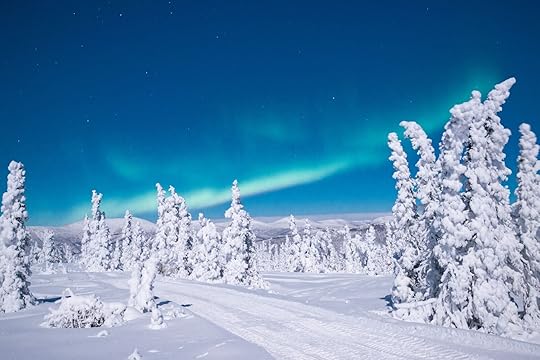
We are all dreaming of a White Christmas, right? While it’s impossible to guarantee a snowy holiday, some places in the US are far more likely to deliver on Christmas morning. To help you plan your winter getaway, car rental company SIXT, has analyzed historical weather data to identify the top 25 US destinations with the highest probability of a White Christmas.
It’s too early to say for sure where we will get snow on the big day, but long-range weather forecasts are nodding towards a slightly higher-than-normal chance that we’ll get colder and drier conditions in the run-up to Christmas. The likelihood of a White Christmas varies across the country, with regions in the north and at higher altitudes generally having a better chance.
SIXT examined data from the National Oceanic and Atmospheric Administration (NOAA) to assess the average chance of snowfall on Christmas Day for various locations across the country. This information was cross-referenced with local holiday event calendars to identify places that offer a wealth of festive activities, ensuring a truly magical winter experience.
“A White Christmas is a magical experience that can turn a simple holiday trip into a memorable adventure. By combining a high likelihood of snowfall with a variety of festive activities, these destinations offer the perfect setting for a winter wonderland getaway. Whether you’re seeking a cozy mountain retreat or a bustling city with holiday cheer, these top 25 locations have something for everyone,” says Jen Adams, Head of Partnerships and travel expert at SIXT.
So, where should you go to increase your chances of waking up to a blanket of powder? Fairbanks, Alaska — commonly known as America’s coldest city — takes the top stop with a near-guaranteed 100 percent chance of snowfall. Fairbanks, being only 120 miles south of the Arctic Circle, has limited daylight hours at this time of year, but that means there are excellent conditions for viewing the northern lights. Couple that with experiences like dog sledding, ice fishing, cross-country skiing, and staying in a remote log cabin in a snowy forest; you’ve got a recipe for an unforgettable winter vacation. Renowned ski resort town Aspen takes second place for the promise of snow and world-class skiing, snowboarding, and après-ski activities. Breckenridge, another Colorado winter hotspot, takes third place for an almost guaranteed dumping of powder and a range of winter activities.
Traveling this winter? Check out Matador’s accommodations guides in snowy destinations: Top Arctic Airbnbs for a Dazzling Northern Lights Experience in the New Year This Ritzy Aspen Hotel Is Famous for Its Personalized Butler Service The Best Ski and Spa Resorts in North America Stunning Aspen Airbnbs to Take in the Country’s Most Glamorous Mountain Town Sleep Near the Slopes and the Pubs at These Breckenridge Airbnbs Get Cozy in These 10 Lake Tahoe Cabins and Mountain Homes on AirbnbHere’s a full list of the top 25 destinations:
1. Fairbanks, Alaska — 100 percent chance of a White Christmas
2. Aspen, Colorado — 99.9 percent
3. Breckenridge, Colorado — 97.7 percent
4. Marquette, Michigan — 95.6 percent
5. Duluth, Minnesota — 92.2 percent
6. Bozeman, Montana — 91.1 percent
7. Idaho Falls, Idaho — 88.1 percent
8. Laramie, Wyoming — 78.4 percent
9. New Hope, Minnesota — 78.8 percent
10. Fargo, North Dakota — 77.6 percent
11. Sioux Falls, South Dakota — 77.6 percent
12. St. Cloud, Minnesota — 76.5 percent
13. Minneapolis, Minnesota — 73.6 percent
14. Eau Claire, Wyoming — 73.7 percent
15. Casper, Wyoming — 70 percent
16. Green Bay, Wisconsin — 66.3 percent
17. Missoula, Montana — 65.9 percent
18. Burlington, Vermont — 62.3 percent
19. Concord, New Hampshire — 62.6 percent
20. Bangor, Maine — 61.1 percent
21. Mason City, Iowa — 60.5 percent
22. Grand Rapids, Michigan — 55.6 percent
23. Syracuse, New York — 56.3 percent
24. Rochester, New York — 51.5 percent
25. Ithaca, New York — 51.2 percent
Whether you’re seeking a peaceful family getaway or an action-packed winter vacation, these 25 destinations offer the perfect blend of snow, fun, and holiday cheer. 
World Leaders Failed to Properly Address Climate Change This Year. Responsible Tourism Can Help Fill the Gaps.
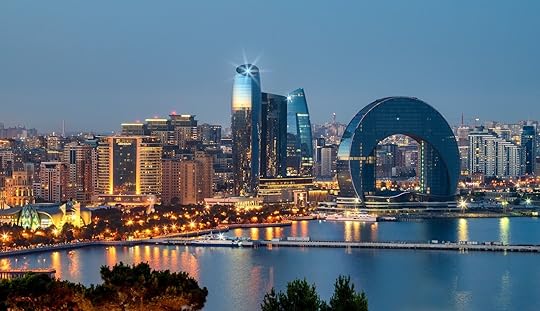
The COP29 summit is behind us, having wrapped up its 12-day run in Baku, Azerbaijan, on November 22. Seeking to unite global governments and economies around the transition to renewable energy and preservation of the natural order, the summit instead narrowly avoided collapse. Even the resulting agreement, which saw wealthy nations triple their financial commitment to developing countries, required immense compromise and fell short of what experts believe is needed. The deal reached at the Baku summit requires wealthy nations to lead in raising $300 billion annually by 2035 to support climate action in developing countries. Given past performance and the less-than-binding nature of the agreement, there are significant doubts about whether even this goal will be realized.
The takeaway for travelers is this: We can and must play a significant part in moving this goal forward. We cannot trust federal governments alone to solve the climate crisis, and instead must take matters into our own hands where we can. To do so, we must be diligent about where our travel dollars are going – especially when traveling in less-developed countries.
Here’s where it gets good, though. Traveling responsibly gets increasingly easier year over year, thanks to increased awareness of the importance of sustainable travel and the growing cohort of startup businesses committed to making it happen.
What happened at COP 29?
Photo: Zulfugar Graphics/Shutterstock
Despite securing a deal, the real challenge lies in translating these pledges into tangible financial support for vulnerable nations. Developing countries are increasingly vulnerable to the impacts of a warming planet, a matter made worse by the inability of wealthy nations – responsible for the bulk of historic emissions – to agree to provide proper funding to help mitigate its impacts.
The $300 billion annually by 2035 to support climate action in developing countries falls short of initial expectations. Additionally, the agreement only voluntarily encourages other donors, including China and private investors, to contribute towards a more ambitious goal of $1.3 trillion.
As such, COP29 will widely be viewed as a failed exercise. Rather than the groundbreaking agreement and diplomacy the world needs right now, we witnessed a petrostate host praising fossil fuels as a “gift from God” amid accusations of backdoor promotion of fossil fuel deals taking place onsite and visibly decreased authority and leadership from the country that has polluted the most.
“The commitments made in Baku — the dollar amounts pledged and the emissions reductions promised — are not enough. They were never going to be enough,” Ralph Regenvanu, climate envoy from the island nation Vanuatu, told Semafor. “And even then, based on our experience with such pledges in the past, we know they will not be fulfilled.”
What role do travelers play going forward?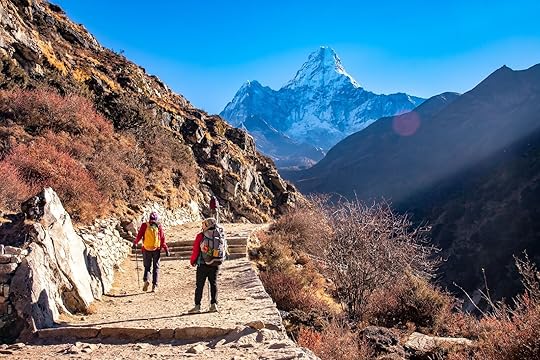
Photo: sumankyal /Shutterstock
As a travel editor, I firmly believe that travel has the power to open minds to the inalienable dignity of life everywhere on this planet. More importantly, as a concerned citizen, I believe that the dollars spent to gain that wisdom can and should simultaneously take root in the places we visit, supporting conservation-minded tourism economies centered around the responsible protection of land and wildlife, the preservation of diverse cultures and cuisines, and the awareness that we’re all in this together.
If you take this stance as I do, it’s easy to see that travelers can yield significant leverage. Using our dollar and time to enact positive change is inspiring, and it’s also our duty. Traveling responsibly provides better travel experiences while putting money into the right place. This, in turn, builds resilient economies in the right way. One recent example is Namibia, a compelling – and fluid – example of how tourism can drive conservation efforts. By empowering local communities through its Community-Based Natural Resource Management Programme (CBNRM), Namibia, its residents, and its visitors have helped develop a long-term commitment to responsible tourism that has generated millions of dollars for wildlife conservation, habitat protection, and anti-poaching initiatives through the Community-Based Natural Resource Management Trust Fund. Simultaneously, these efforts have highlighted Namibia’s rich cultural and culinary heritage, particularly those of the San people and the Himba tribe. Travelers must eat, after all, and visiting wild and remote landscapes like Etosha National Park requires at least some interaction with the communities that live near and protect the area.
“Thinking about the manner in which travel dollars are spent matters now more than ever,” Alexis Bowen, co-founder of tour operator Elsewhere by Lonely Planet, told Matador via email. Elsewhere specializes in tours led by local guides that showcase a community or place as it is, and as it wishes to be seen. The company’s tours are as nimble as the guides and travelers that experience them – a fact rooted in the fluid nature of areas both vulnerable and established.
Bowen encourages travelers to consider not just where they go and how they spend, but how they arrive to place and how long they spend there.
“What we need to remember is that sustainability is a spectrum and it cannot be looked at through a binary lens,” Bowen says. “Take flying for example, eliminating air travel altogether isn’t practical, but thinking intentionally about flying, when you choose to fly and how frequently, can have a huge impact. Prioritize slow travel in a bid to make the most of each flight. Some things we can ask ourselves – am I being extractive in my travels? And how can I best offset that by empowering local communities?”
She notes that 1 in 10 people globally work in tourism – and for many communities served by Elsewhere and other boutique operators, tourism is a primary source of income, as seen in the Namibia example discussed above. Bowen offered ideas about specific actions travelers can take.
Choose to support the right businesses.Support initiatives that feed back to the local economies.Prioritize local at every turn. Seek out locally owned restaurants, stay in locally owned accommodations, andbook activities with local providers.Lean toward activities that are enriching, but don’t environmentally degrade the land.Choose alternatives to well-trodden hot spots or visit peak attractions in off-peak season or off-peak hours. Overtourism distorts the social contract between travelers and local people in what should be a balanced relationship. When that balance gets out of sync, it becomes difficult for tourism to have a positive impact on local economies and in the hearts and minds of locals.
In short, research the tour operators, accommodations, and other facilities where you spend money while traveling to ensure they are locally owned and environmentally conscious. We can’t be perfect every time, but a modicum of effort can notably move the needle in the right direction.
The role travel played at COP29
Photo: Rustamli Photos /Shutterstock
On November 20, the COP 29 agenda included a segment called the Presidential Initiative on Enhanced Climate Action in Tourism, the first time such a focus on travel was included in the summit. Its goal, according the United Nations World Tourism Organization, was to “enhance the positioning of tourism climate action globally as a sectoral policy supporting national climate goals.” This signifies that the UN and global delegates understand the impact travel can have and the importance of it being done in a responsible manner.
The “Tourism Day,” as it was dubbed, sought to strengthen the Glasgow Declaration on Climate Action in Tourism, which seeks to halve emissions in the travel sector by 2030 en route to “net zero” by 2050. It’s going to take all of us to make this happen – and it just might be COP 29’s best chance at a successful outcome. We can make that be so.
“Remember that 80% of low-income countries rely on tourism as a means of improving their economic situation,” Bowen says. “These are the places that need tourist dollars the most, but in order to actually positively impact these host communities, travelers need to be conscious of how their dollars are spent.” 
How to See All of Rome’s Highlights on a One-Day Walking Tour

To see Rome properly, you need several days, maybe even a week. Cruisers don’t have that privilege, however. Cruise lines that advertise the Eternal City on their itineraries don’t actually dock in the non-coastal Italian capital, but in Civitavecchia, a port city located 43 miles northwest of Rome. Despite the distance, and the short time allotted to cruisers in Rome (usually one day), it’s possible to see the highlights of the city in five hours or less.
How to get to Rome from Civitavecchia?There are multiple ways to get from Civitavecchia to the center of Rome:
There are trains, including high-speed ones, operating very regularly between the two cities. The ride takes between 50 minutes and one hour, but you have to get to the train station from the ship, which will require a taxi or Uber ride.You can book a taxi or Uber to get there and back, but it’ll cost you big. There are many companies offering shuttles (shared or private) that can be booked in advance for a more reasonable rate.The most secure way to get to Rome and back, however, is to book the transfer between the two cities as an excursion via your cruise line. A bus will pick you up, along with dozens of other passengers, as you exit the ship and drop you off in the heart of the city after a 90-minute ride. A guide will accompany you during the journey and provide you with a map and their phone number in case of emergency, but you’ll be left alone to explore for the entire day. The guide will also give you a meeting point for the journey back to the ship, and make every effort to find you if you don’t show up, so you’re sure not to miss the crucial all-aboard time. The price of a such a bus transfer is usually much cheaper than a privately booked shuttle.A free walking tour of Rome to see all the highlightsA walking tour that shows the highlights of Rome does not allow for hours spent at each location. That means that if you want an in-depth visit of the Colosseum or the Vatican Museum and you only have one day, you should book your ticket/tour well in advance and focus all of your time at that particular site. Then, if you have any time remaining, try to see a couple more monuments from the streets by using the map below.
Cruise line transfers often drop guests at Circus Maximus or Piazza del Popolo, both of which can be used as starting points for this walking tour. If your bus transfer drops you elsewhere, it’s extremely likely to be close to points on the following walking itinerary so you can join in easily. For the purpose of this map, I used Piazza del Popolo as the starting point.
The map and walking tour detailed below only offer suggestions made from my personal experience of multiple on-day trips in Rome; you can tailor it to your preferences, time on site, and walking abilities.
Starting and ending point: Piazza del Popolo
Photo: AlexAnton/Shutterstock
Piazza del Popolo (People’s Square) is a large pedestrian square that is located in the heart of Rome. A monumental Egyptian obelisk marks the center of Fontana dei Leoni (Fountain of the Lions) and its four basins, as well as the center of the piazza itself. Benches are situated around the fountain for passersby to take a seat and partake in some people watching.
Just above Piazza del Popolo, up a steep mrable staircase, are the Villa Borghese Gardens, whose tall trees provide a welcome respite from the Italian sun. Terrazza de Pincio (Pincio Terrace), located on the edge of the gardens, offers gorgeous views of the piazza and the surrounding area. After taking in the cityscape, walk the paths that meander further into the leafy gardens and check out the unusual 19th-century water clock. Note that there is a public bathroom near Terrazza de Pincio, one of the few in Rome’s center. You need to have €2 ($2.10) in cash to use the facilities but they are clean and a lifesaver if you’re desperate.
Piazza di Spagna, Spanish Steps, and the Church of Trinità dei Monti
Photo: AlexAnton/Shutterstock
Just seven minutes from Piazza del Popolo is Piazza di Spagna, with its 17th-century Baroque-style fountain that resembles a sinking boat. Piazza di Spagna is the starting point of the famous Spanish steps, which you can climb to go all the way up to the Church of Trinità dei Monti from where the view of Rome is extraordinary. The luxurious Hassler Hotel, located steps away from the Church of Trinità dei Monti, arguably has the best location in the city.
Trevi Fountain, Column of Marcus Aurelius, and the Church of St. Ignatius of LoyolaSix minutes from the Spanish Steps is the most famous fountain in the world: the 85-foot-tall Trevi Fountain. Like every big site in Rome, visiting early in the morning is the best chance to see the monument without crowds, but if you can’t be there at 7 AM, you’re just going to have to make do. Line up among the hundreds of others to reach the basin and throw a coin (or two, or even three) in its water. The sight is impressive and worth the wait.
Just four minutes away is Piazza Colonna, named as such for the immense Column of Marcus Aurelius located in its center. It’s a quick and easy sight but it warrants a detour.

The ceiling of the Church of St. Ignatius of Loyola. Photo: essevu /Shutterstock
Next up, after a three-minute walk, is the Church of St. Ignatius of Loyola, one of Rome many catholic sites, but one that you’d be remiss to pass on. It’s free to enter and walk around the see the various chapels. Take a seat in a pew to rest your legs if need be. The painted ceiling is the most impressive part of the church and you can line up and pay €1 ($1.05) to see it through a mirror and take a selfie. But, if you’re cheap like me, just crane your neck for a few minutes. The false painted dome, which nowadays doesn’t fool visitors, is a fun sight.
Monument to Victor Emmanuel II, Basilica Santa Maria in Aracoeli
Photo: Sopotnicki/Shutterstock
A 15-minute walk from the the Church of St. Ignatius of Loyola is the Monument to Victor Emmanuel II, the first king of unified Italy. The site, finished in 1935, is huge and a bright shade of white, immediately catching the eye of passersby. The gigantic equestrian statue of Victor Emmanuel II in front of it is equally impressive.
Just behind the Monument to Victor Emmanuel II, up a steep, 124-step marble staircase, is the Basilica Santa Maria in Aracoeli. It is free, and highly recommended, to enter and take a look inside this beautiful sacred edifice whose origins date back to the sixth century.
Roman Forum, Colosseum, Circus Maximus
Photo: Adisa/Shutterstock
The Roman Forum (the center of life in ancient Rome), the Colosseum (amphitheatre), along with Palatine (the oldest part of the city of Rome) can all be visited on one ticket purchased in advance; however, if you don’t want to spend the entire day there, you can partially see all three from the streets. The Roman Forum can be seen quite easily from Via dei Fori Imperiali, the Colosseum is so large that it’s unmissable from this area, and from Circus Maximus, you’ll be able to see the side of the palace on Palatine Hill. The Roman Forum is located five minutes on foot from Basilica Santa Maria in Aracoeli, while the walk between the Roman Forum, the Colosseum, and Circus Maximum takes around 20 minutes.
The cats at Largo di Torre Argentina and the PantheonThe walk from Circus Maximus to Largo di Torre Argentina takes about 20 minutes. Largo di Torre Argentina is an archeological site home to the remains of four ancient Roman temples, and the site of Jules Cesar’s assassination in 44 BC. Since the site’s excavation in the 1920s, cats have settled there, and Largo di Torre Argentina is now a cat sanctuary home to 150 cats who are fed and taken care of by a charitable organization. As of yet, visitors can only see Largo di Torre Argentina (and the cats) from the streets and from behind low barriers.

Photo: Heracles Kritikos/Shutterstock
Only seven minutes on foot from Largo di Torre Argentina, the Pantheon is a church like no other. The former Roman temple converted into a Catholic church in the year 608 is circular in shape, covered in marble, and its immense dome has a large and most unusual oculus. Visiting the Pantheon costs €5 ($5.24); if you opt to pay by card instead of cash, you’ll skip the long line at the front.
A much-deserved stop for lunch: All’Antico Vinaio and Piazza Novana
Photo: Antonio Gravante/Shutterstock
After all this walking, it’s time for sustenance. Join the long, but fast-moving, line in front of All’Antico Vinaio, located just two minutes from the Pantheon, for a large, creamy, and packed focaccia sandwich you won’t soon forget. While meat, especially pork, is the focus, there are dozens of options, including some for vegetarians with pistachio cream, mozzarella, and sundried tomatoes. Note that there are no tables and seats at this venue; once you get your sandwich, you can walk a few minutes to Piazza Novana and find a seat on the edge of a fountain, a bench, or a few steps. Piazza Novana, a oval-shaped square where an ancient stadium once stood, is adorned by three magnificent fountains, all of which are worth taking the time to admire.
Gelato for desert at FrigidariumNo walking tour of Rome would be complete without a quick stop at a gelateria. If you still have room for desert after your supersized sandwich, make your way to Frigidarium, just three minutes away from Piazza Novana. The shop, here since 1988, serves delicious gelato for a very reasonable price — just €5 ($5.25) for three flavors in a cup.
Sant’Angelo Bridge, Castel Sant’Angelo, and the VaticanIf you still have any energy left after this long day of walking between historical sights, cross the River Tiber via the famous second-century Sant’Angelo Bridge. St. Angelo Bridge leads to Castel Sant’Angelo, the circular mausoleum of Emperor Hadrian, and a sight to behold. Note that there is a public bathroom near Castel Sant’Angelo on the way to Vatican City, and you should make good use of it since it might be the last one you encounter for the day — just make sure you have some cash to give the attendant who keeps the facilities spotless.

Photo: Nakasaku/Shutterstock
From Castel Sant’Angelo to St. Peter’s Basilica is a 13-minute walk, but if you want to see the biggest church in the world, you have to put in some efforts. The line to get in St. Peter’s Basilica is long and requires a security check, but it moves very fast. Although, if you are short on time, you might have to see it from the outside only. Entry is free, but you need to be dressed modestly to enter — no short shorts and tank tops. Inside, the space is so large and ornate, it’s easily to believe this is the center of the Catholic world. The Vatican’s post office on St. Peter’s Square is a good place to send a postcard home if you have the time.
From St. Peter’s Basilica, it’s a 30-minute walk back to Piazza del Popolo. Make sure you’re on time or the bus will leave without you, and so will the cruise ship. 
Wellness and Sustainability Shine at This Historic Eco-Resort in the Austrian Alps

I arrived at the airport in Houston, boarded my flight to Munich, whisked across the Atlantic, hopped into my cab bound for Austria, and just like that – though after twelve hours of travel – I was at the gates of Der Stanglwirt. A 400-year-old “biohotel” in the heart of the Austrian Alps – only closing once, for the COVID-19 pandemic, in all its years of operation – Stanglwirt comes with many surprises, not least of which is how easy it is to reach despite existing a continent away. Nearly every major American city has direct routes to Munich courtesy of United Airlines, and after landing, the resort is only an hour-long shuttle ride away, with the ride arranged by the property.
Sustainability and harmony with nature are the core values of Stanglwirt, which was immediately apparent upon setting foot inside. A fresh scent of wood greeted me in a massive lobby that towered several floors above, where all perceivable surfaces – floors, walls, ceilings, check-in desks, the bar, and even the very frames of the elevators themselves – were dominated by a pervasive timber aesthetic, the wood for which, I learned. was all harvested from surrounding forests. As I marveled at this interior, I couldn’t help but imagine how cozy it must be in the winter months, picturing the currently silent fire pits roaring against the frosty backdrop of drifting white snow through the windows.
My daydreaming was cut short by the sensation of a key card entering my hand, and I began the journey to my room on the opposite end of the complex. I don’t use the word “journey” lightly – with its four centuries of additions, Stanglwirt seemed to have endless corridors, each containing charming discoveries that made me all too happy to get lost exploring them. Over the next several days I regularly fought difficult temptations to not follow beckoning side paths, though I often gave in. On such occasions, I encountered a bar, a library, a cigar room, a gift store, outdoor gear shops, a horse-riding rink, an arcade, a children’s nursery, swimming pools, a giant open-air patio, an enormous spa area, two restaurants, and a well-equipped gymnasium lined with images of occasional guest Arnold Schwarzenegger. There were also fitness classrooms offering yoga, pilates, and much more.
Exploring the amenities at Der Stanglwiort
Photo: John Sizemore
I could only give the spa a precursory glance on this initial trek with belongings in tow, so I chucked my stuff in my room and decided to go check it out. Taking a back entrance directly underneath me, I walked a long carpeted hallway with soothing lounge music and a pleasurable citrus aroma, both increasing in intensity as I followed them towards the gentle sound of trickling water.
On arrival, the full breadth of the spa became evident, which was much more extensive than I had originally imagined. A door to my right revealed a water park hidden in plain sight, where playful screams careened down thrilling slides and culminated in rousing final splashes. To my left, a breezy veranda with dormant fireplaces adjoined two swimming pools inset within an expansive outdoor area. Relaxed guests enjoyed the Alpine sunshine in lazy chairs scattered throughout the grass, with cocktails in hand supplied by a nearby bar.
It seemed impossible to fathom that all this was in one resort, so I took this left exit outside to build a quick mental map. The buildings I had been exploring, tall stone structures half-sunken into the earth, resembled something straight out of The Shire from Lord Of The Rings, with grassy rooftops affixed to the sizable on-site farm that produced ingredients for Stanglwirt’s restaurants. These literal lofty pastures, visible from my room, often came with the hilarious sight of sheep engaging in some carefree grazing that provided an amusing start to each morning. Despite having never been to the Alps before, I had nearly completely forgotten about the mountains until I saw the gorgeous Wilder Kaiser range towering above the complex as if to remind me of the majestic peaks that encircled me.
Stanglwirt has earned global accolades for its green initiatives
Photo: John Sizemore
Re-entering the building, I went through a new entrance straight ahead and realized the spa improbably just kept going. This door led to a spacious, earthy room with indoor waterfalls, staircases leading to hidden nooks with more spectacular views of Wilder Kaiser, and various rocky swimming pools of numerous sizes, all connected by a stone path intermixed with a trickling stream. Water was visible almost everywhere while walking through the spa area, which flowed freely from Stanglwirt’s Kaiserwasser reservoir and functioned as a vital piece of the resort’s sustainability-focused operations. In addition to being aesthetically pleasing, employed extensively within the spa, and drinkable from the many stations throughout the property, the spring was also utilized in the on-site biomass power plant that fueled Stanglwirt’s heating, cooling, and electrical systems. These green initiatives extend far beyond the hotel – Stanglwirt also assists in global eco-friendly endeavors to construct wells in underserved regions.
A narrow passage carved into an earthen wall here led to intimate sauna quarters, steam rooms, and a shower area with a cold plunge in the corner. I finally came across the actual front entrance nearby, where a staircase flanked by walls of bright green moss led to the massage area where plentiful options for bodywork awaited, including ayurveda, detox therapy, and acupressure.
Incredibly, this still wasn’t the end of the spa – a door I had previously missed on this first walk led to a second, entirely separate, clothing-optional area containing different dry saunas, steam rooms, and a much larger chilly plunge outside with a beautiful view of the mountains. As a big believer in hot-cold therapy, I decided I’d done enough investigating for the day, changed my clothes, and commenced my first of many visits to the hottest of these sauna rooms, aptly named the Kaiser. Clocking in at roughly 200 degrees Fahrenheit, and with windows providing a view of the icy pool whose shimmering surface became more alluring the longer I spent in the heat, I flipped a sand timer next to the door, turned off my eyes, turned on my breath, and reanimated a sweaty 15 minutes later under the frigid waters outside, shaking off the last of my jet lag.
Stanglwirt packed few punches – literally
The author throwing a few punches. Photo courtesy John Sizemore
Many new experiences marked the rest of my time at Stanglwirt. My stops at the sauna occasionally coincided with a guided session where a worker clutching fragrant oils, a large fan, and a bucket of water would set themselves up in the center of the room by the scorching pile of rocks radiating the room’s high temperatures. The oil first filled the space with a sweet odor, followed by wet scoops on the sizzling stones, which vaporized instantly on contact. These splashes had the immediate effect of dramatically increasing the heat in the room, which then wafted towards my wincing face via the application of the fan. While fairly intense, I found these ordeals quite relaxing, especially when balanced with the cold plunge.
Stanglwirt has trained several champion boxers – most famously the Klitschko brothers – and one of my days involved stepping in the ring for an introductory class with resident coach and personal trainer Björn Schulz. After taping my hands and putting on some gloves, we did a few aerobic warmups and practiced punching drills. Along with the engaging workout, I enjoyed learning all the implications on my power, speed, and defense resulting from subtle differences in stance, distance, and momentum. As someone who has always favored more technical exercise, despite the apparent simplicity of boxing, I found witnessing the depth of the sport through this first glimpse fascinating.
The boxing demanded a follow-up massage, so I scheduled an appointment for “rolfing.” I had never heard of this before, and as an experienced yoga teacher familiar with bodywork disciplines, I was excited to try it out. Sascha Bauer, the local expert, guided me through the process. Akin to a very intense massage focusing on the body’s connective tissues, or fascia, the procedure had an immediate effect on my posture and was as informative as it was invigorating. I followed my appointment with some time in the massage lounge, an alluring space with chill ambient music and soft lights illuminating stone walls. These were inset with blue partitions filled with lively, colorful fish, where the combination of post-massage bliss, tea, and comfy vibes led to a restful nap rather than the book I intended to read.
On-site dining at Stanglwirt
The famed Weiner schnitzel. Photo: John Sizemore
Spending time in such comfortable surroundings often whetted my appetite. Having seen the emphasis on freshness, I was eager to try Stanglwirt’s restaurants, whose cuisine covered traditional Austrian dishes and fare from elsewhere in Europe. At Gastof Stangl, where inviting wooden dining rooms evoked a rustic charm with its wooden interior and windows offering the sight of munching cows in farm stalls, I enjoyed tasty white asparagus, a local delicacy popular during the spring months. Stangl Alm, existing about as long as the resort itself and where weathered walls held dozens of artifacts befitting its age, I tried an Austrian classic – Weiner schnitzel – followed with Kaiserschmarrn, a delectable dessert closely resembling a sweet pancake. The mornings didn’t disappoint either. Breakfasts were a tantalizing buffet in yet another new part of the building, where my stomach was delighted to find an appetizing smorgasbord of fresh fruits, succulent sausages, and refreshing juices awaiting me.
As a cheese lover, I was also thrilled that meals typically came with a fine selection of Alpine fromage. I was hardly shocked to eventually discover on a tour that, along with everything else, Stanglwirt also contained a cheesemaking area, complete with a storage cellar embedded in the side of a nearby mountain whose damp climate was ideal for cultivating the delicious dairy.

There’s not a bad seat anywhere on the property. Photo: John Sizemore
One could be easily forgiven for getting swept up in Stanglwirt’s many delights, but considering its location at the doorstep of the Alps, plenty of adventures also await just beyond. Any season features things to do – the property organizes excursions to immerse visitors within its wealth of nearby hiking, fishing, biking, and skiing in the winter months, with shops selling accessories assisting each of the above activities. The surrounding village of Kitzbuhel also exudes small-town Alpine appeal, with its adorable streets lined with cute restaurants and stores begging to be visited.
I was at Stanglwirt for close to a week. As someone who isn’t particularly inclined towards luxury travel and tends to shy away from it, I was not only amazed at the extent to which the resort was able to effortlessly combine a luxurious feel with sustainability in such a vast space, but that it was also able to do so in a way that felt wholly authentic, heartfelt, and inspiring. I was surprised at how often I was pulled towards exploration simply out of the wonder of what I might uncover next, and even though I’m sure there are things I still missed, I’m just as happy to leave a new adventure for the next stay. If you ever find yourself in the magic of the Austrian Alps and want an environment befitting their beauty and splendor, look no further than Stanglwirt. 
Buying a Mid-Flight Snack on United Airlines Just Got a Little Easier

It seems like airline technology is always changing — and not always for the better. But United just announced a technological change that should make alleviating hunger pangs (or at least treating yourself to a high-altitude bloody mary) a smidge easier.
For the last few decades, anyone flying in economy class on a US-based airline has had to pay for alcoholic drinks or snacks, except for on international flights. But United, as well as a few other US airlines, required you to not only have the airline app downloaded, but have a credit card saved to your account. You weren’t allowed to pay with cash or a physical card, which meant if you failed to update your airline app, you’d better be prepared to go hungry.
Fortunately, United just reversed that policy. The airline confirmed to Travel + Leisure earlier this week that as of November 18, 2024, travelers do not need the United App or a saved credit card to pay. Now, travelers can use any tap-to-pay method for treating themselves on board United flights, including actual cards, iPhones or other smartphones, or even devices like Apple watches. All domestic flights in the US now have that feature, though it’s not available on all international flights. Fortunately, United offers complimentary wine and beer for all guests (including economy passengers) on most international flights, as well as one or two meals on flights to or “from Asia, Europe, the Middle East, the South Pacific and select destinations in Latin America.”

On domestic United flights, this is about as much as economy-class passengers will get without paying. Photo: Deutschlandreform/Shutterstock
However, there is a reason you may want to keep the app handy, at least if you’re a frequent flyer: United allows passengers to buy food and drinks using miles. It’s convenient for people who have more miles than they need, but aren’t keen to pay $10 for a cinnamon roll with cream cheese frosting. But it’s not always the best deal. For example, the same cinnamon roll costs 1,180 miles, which an online frequent flyer miles calculator estimates is equivalent to about $14. You can also use miles to pay for on-board Wi-Fi on domestic flights, at a cost of 800 miles or $8 (or $10, if you’re not a MileagePlus member). 
The World’s Most Stunning Geysers You Can Visit: A Visual Guide

Geysers are among nature’s most breathtaking spectacles, combining raw geothermal power with mesmerizing beauty. Found in tectonically active regions, these hot springs erupt with jets of boiling water and steam, creating dramatic plumes against landscapes that range from volcanic valleys to snow-covered plains. While each geyser has its own unique rhythm and intensity, all share a sense of mystery that has drawn explorers, scientists, and tourists for centuries. This collection of the world’s most visually stunning geysers highlights both famous and lesser-known geothermal marvels that you can see in person (with varying degrees of difficulty), from the reliable Old Faithful in Yellowstone to the remote, otherworldly geyser fields of Russia’s Kamchatka Peninsula.
Old Faithful: Yellowstone National Park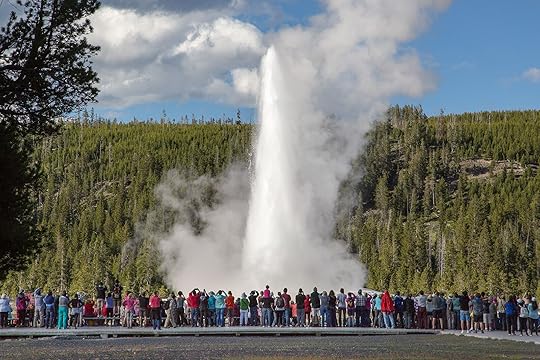 Photo: NPS/Neil Herbert
Photo: NPS/Neil Herbert Photo: Green Mountain Exposure/Shutterstock
Photo: Green Mountain Exposure/Shutterstock Photo: NPS/Jim Peaco
Photo: NPS/Jim Peaco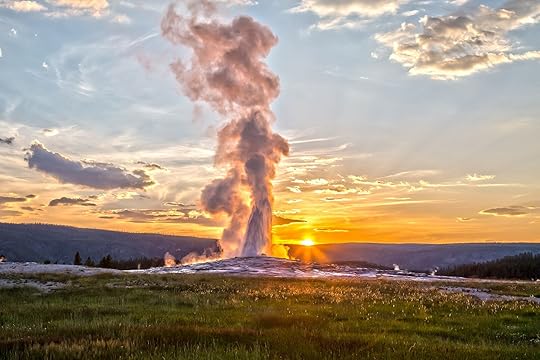 Photo: Susanne Pommer/Shutterstock
Photo: Susanne Pommer/ShutterstockThere are approximately one thousand geysers around the world, and about half of them are in Yellowstone National Park. Old Faithful stands out as the most iconic—and most visited—geyser, not just in the park, but globally. Named in 1870 for its predictability, Old Faithful erupts about every 90 minutes, sending water soaring between 100 and 180 feet high. Each eruption releases up to 8,400 gallons of boiling water, making it a spectacular and reliable attraction for visitors for centuries.
Nearest City: West Yellowstone, Montana
Accessibility: Very accessible via a short, easy walk from the Old Faithful Visitor Center parking lot. There’s a boardwalk around the geyser for prime viewing.
Stay: Airbnbs near Yellowstone National Park.
Great Geysir: Haukadalur Valley, Iceland
 The landscape of Haukadalur Valley. Photo: Photo: Aerial Film Studio/Shutterstock
The landscape of Haukadalur Valley. Photo: Photo: Aerial Film Studio/Shutterstock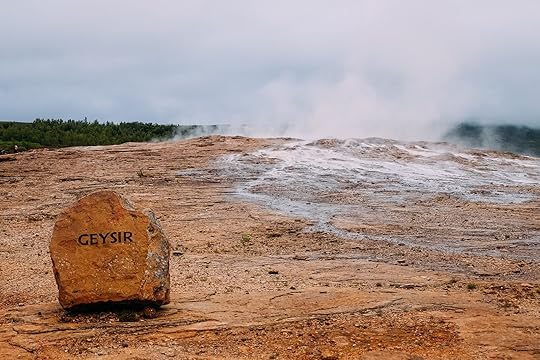 A stone tablet marks the location of Iceland's famous geyser. The Great Geysir has only erupted twice in the last 24 years. Photo: Dobrovizcki/Shutterstock
A stone tablet marks the location of Iceland's famous geyser. The Great Geysir has only erupted twice in the last 24 years. Photo: Dobrovizcki/ShutterstockIceland is a hub of geothermal activity and is home to the geyser that gave its name to all others: the Great Geysir. Records of the area’s geothermal activity date back to 1294, and the term “geysir” was first documented in 1647, specifically to describe the Great Geysir after a period of intense eruptions. Over the centuries, the Great Geysir’s activity has fluctuated, ranging from several daily eruptions to prolonged dormancy. Today, Geysir is mostly inactive, but on rare occasions, it still erupts with water columns reaching up to 230 feet.
Nearest City: Reykjavik
Accessibility: Easily accessible via a paved path from the nearby parking area.
Stay: Airbnbs in Reykjavik.
El Tatio Geyser Field: Atacama Desert, Chile
 Photo: Bogdan PV/Shutterstock
Photo: Bogdan PV/Shutterstock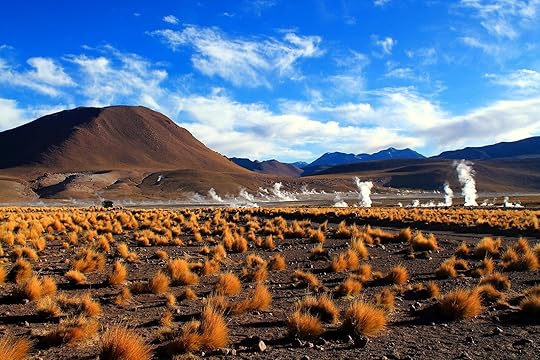 Photo: pickypalla/Shutterstock
Photo: pickypalla/Shutterstock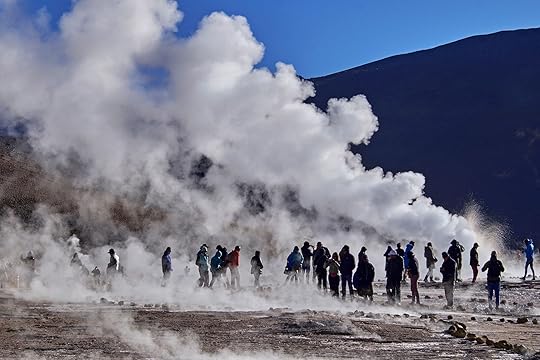 Photo: Shee Heng Chong/Shutterstock
Photo: Shee Heng Chong/ShutterstockLocated at 13,800 feet in the Andes Mountains, El Tatio is one of the largest and highest-altitude geyser fields in the world. The area boasts more than 80 active geysers and an estimated 400 geothermal manifestations, including hot springs and fumaroles. In the early morning, El Tatio’s geysers create a spectacular cloud of steam rising from the desert floor, which is one of the field’s main attractions.
Nearest City: San Pedro de Atacama
Accessibility: Accessible by vehicle, but requires a long drive from San Pedro and a short walk on a rocky, elevated path around the geyser field.
Steamboat Geyser: Yellowstone National Park
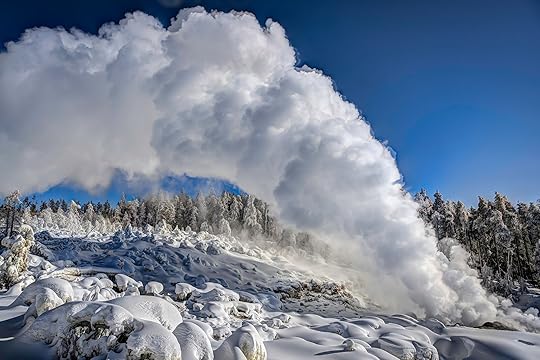 Photo: Laura Heiden/Shutterstock
Photo: Laura Heiden/Shutterstock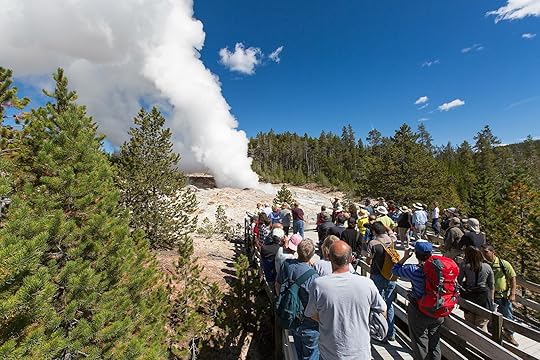 Photo: NPS/Neil Herbert
Photo: NPS/Neil Herbert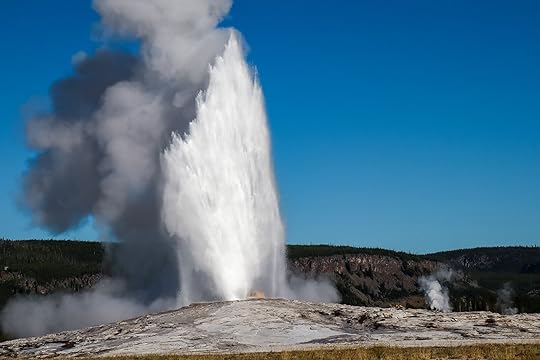 Photo: Vivian Barra/Shutterstock
Photo: Vivian Barra/Shutterstock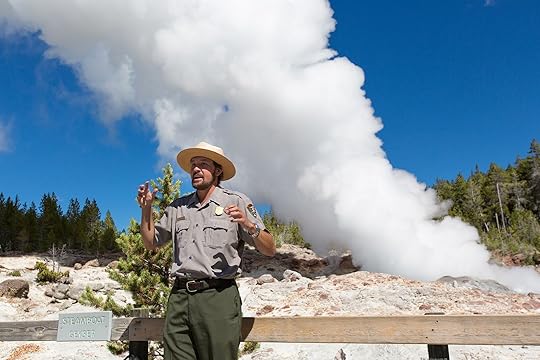 Photo: NPS/Neil Herbert
Photo: NPS/Neil HerbertWhile Old Faithful is Yellowstone’s most famous geyser, it’s not the tallest. That title goes to Steamboat Geyser, the world’s tallest active geyser that’s capable of shooting water up to 300 feet in the air. However, Steamboat is highly unpredictable and can go dormant for extended periods. The geyser is currently in an active phase, with five major eruptions through December 2024, though the timing of eruptions remains erratic.
Steamboat holds the record for the largest active geyser eruptions in the world today, but the most powerful geyser eruption on record belongs to New Zealand’s Waimangu Geyser. From 1900 to 1904, Waimangu produced massive eruptions that reached up to 1,500 feet before going extinct by 1908.
Nearest City: West Yellowstone, Montana
Accessibility: Located along the Norris Geyser Basin Trail, requiring a short walk from the Norris Geyser Basin parking lot.
Lady Knox Geyser: Taupo Volcanic Zone, New Zealand
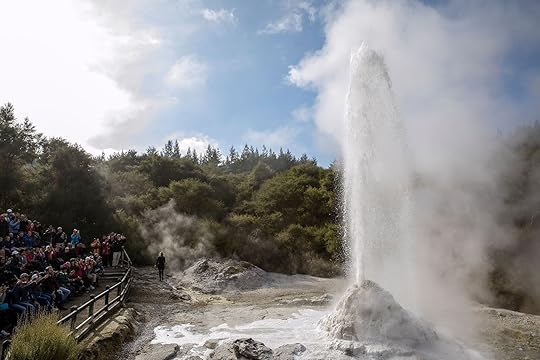 Photo: Tourism New Zealand/Matt Crawford
Photo: Tourism New Zealand/Matt Crawford Photo: Photofex_AUT/Shutterstock
Photo: Photofex_AUT/ShutterstockLady Knox Geyser was discovered in the early 20th century in a rather unusual way. Inmates from the nearby Waiotapu open prison were washing their clothes in the thermal waters when the soap they used accidentally triggered a chemical reaction that ended up with the geyser erupting. Today, Lady Knox is a popular tourist attraction, with eruptions triggered daily at 10:15 AM by adding chemicals to stimulate the reaction.
Nearest City: Rotorua
Accessibility: Directly accessible from the Wai-O-Tapu parking lot with a short walk to the seating/viewing area.
Strokkur: Haukadalur Valley, Iceland
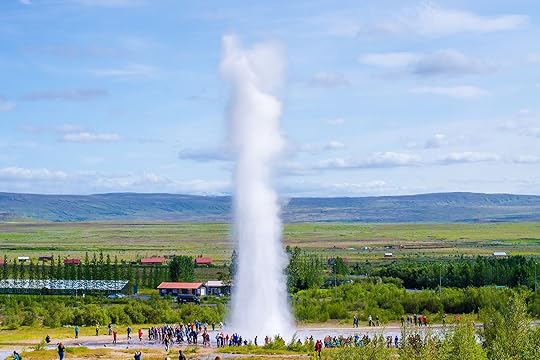 Photo: Simon Dannhauer/Shutterstock
Photo: Simon Dannhauer/Shutterstock Photo: Dennis van de Water/Shutterstock
Photo: Dennis van de Water/Shutterstock Photo: Beketoff/Shutterstock
Photo: Beketoff/Shutterstock Photo: Zinaida Sopina/Shutterstock
Photo: Zinaida Sopina/ShutterstockNeighboring the famed Great Geysir in Iceland’s Haukadular Valley, Strokkur is the region’s most reliable geyser, erupting every few minutes with impressive regularity. Each eruption begins with a steam bubble forming beneath the surface, followed by a burst of water that can reach up to 100 feet. First documented in 1789, Strokkur’s activity has varied over the centuries, but it remains one of Iceland’s most popular natural spectacles.
Nearest City: Reykjavik
Accessibility: Easily accessible with a short walk from the parking area along a well-maintained path.
Castle Geyser: Yellowstone National Park
 Photo: Robert Harding Video/Shutterstock
Photo: Robert Harding Video/Shutterstock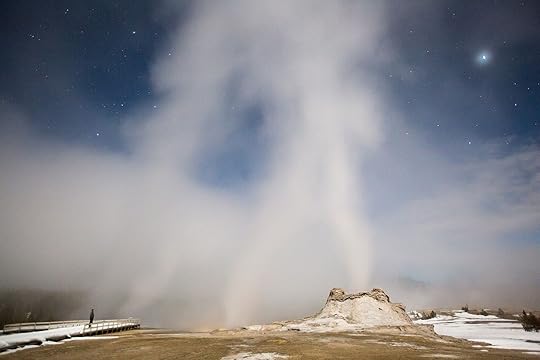 Photo: NPS/Neal Herbert
Photo: NPS/Neal Herbert Photo: NPS/Jim Peaco
Photo: NPS/Jim Peaco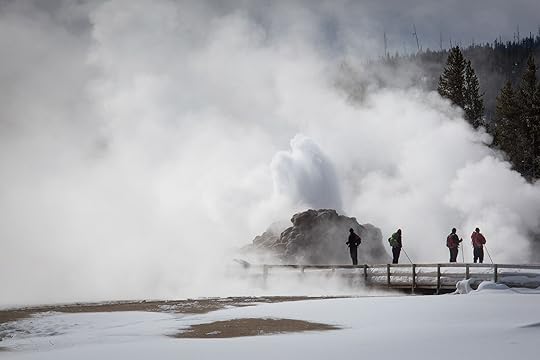 Photo: NPS/Neal Herbert
Photo: NPS/Neal HerbertCastle Geyser, named for the castle-like structure created by its mineral deposits, is one of the oldest geysers in Yellowstone’s Upper Geyser Basin and boasts the largest cone in the area. It erupts on a cycle of 10 to 16 hours, beginning with a 20-minute water phase that can reach heights of up to 90 feet, followed by a loud steam phase. The entire eruption sequence can last up to 40 minutes, offering an impressive display of geothermal power.
Nearest City: West Yellowstone, Montana
Accessibility: Easily accessible by a short walk from Old Faithful, following a trail in the Upper Geyser Basin.
Valley of Geysers: Kamchatka Peninsula, Russia
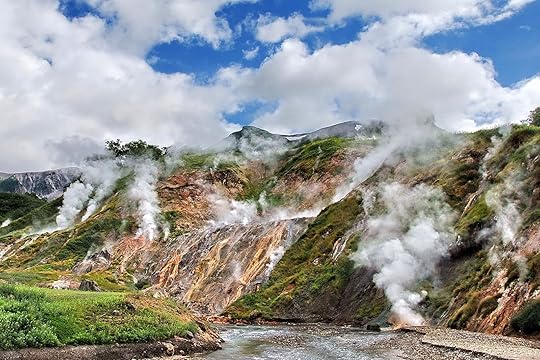 Photo: AlexUm5/Shutterstock
Photo: AlexUm5/Shutterstock Photo: Yuri-D3/Shutterstock
Photo: Yuri-D3/Shutterstock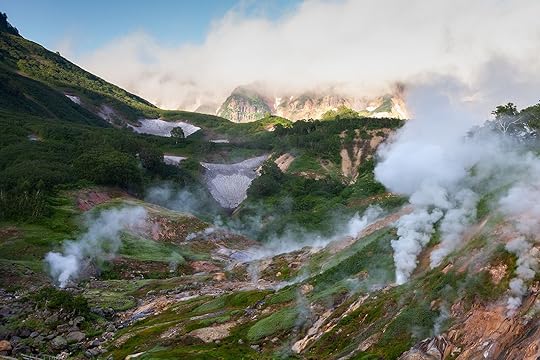 Photo: Sergey Krasnoshchokov/Shutterstock
Photo: Sergey Krasnoshchokov/Shutterstock Photo: Okyela/Shutterstock
Photo: Okyela/ShutterstockLocated within the Volcanoes of Kamchatka World Heritage Site, the Valley of Geysers is the second largest geyser field in the world with more than 90 active geysers. The site was significantly impacted by a massive mudflow in 2007, which caused widespread damage. However, almost two decades later, most of the geysers have reemerged, and the valley has almost fully recovered. One of the most notable features is the Velikan Geyser, also known as the Giant, which can shoot water columns up to 130 feet high.
Nearest City: Petropavlovsk-Kamchatsky
Accessibility: Highly remote, only accessible by helicopter tours from Petropavlovsk, which include guided walks in the valley.
Fly Ranch Geyser: Washoe County, Nevada
 Photo: Rylandwest/Shutterstock
Photo: Rylandwest/Shutterstock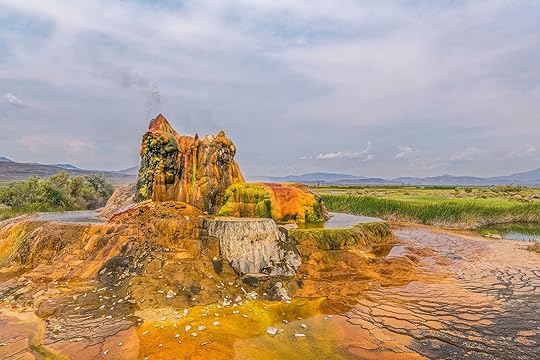 Photo: Gary Gilardi/Shutterstock
Photo: Gary Gilardi/Shutterstock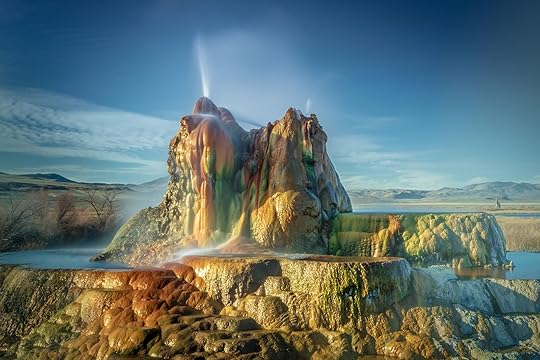 Photo: Alexandre Olive/Shutterstock
Photo: Alexandre Olive/ShutterstockFly Ranch Geyser has an origin story unlike any of the other geysers on this list. In 1916, a search for irrigation water led to drilling into a geothermal deposit by accident. The project was abandoned until the 1960s, when a geothermal company resumed drilling. Once again, the project was abandoned due to the water not being hot enough, and the well was capped. The pressure of the geothermal deposit eventually caused the seal to break, allowing the flow of mineral-rich water to form the geyser’s distinctive cones and travertine pools. The bright reds and greens that characterize Fly Ranch Geyser are due to the thermophilic algae that thrive on its surface.
Nearest City: Gerlach, Nevada
Accessibility: While on private property, Fly Ranch Geyser can be visited on guided tours managed by the Friends of Black Rock-High Rock. Tours are available from April to October.
Pōhutu Geyser: Whakarewarewa Thermal Valley, New Zealand
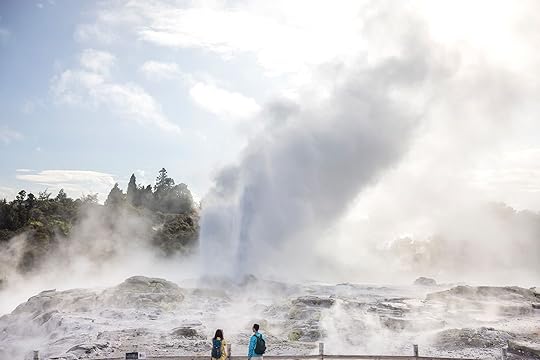 Photo: Tourism New Zealand/Miles Holden
Photo: Tourism New Zealand/Miles Holden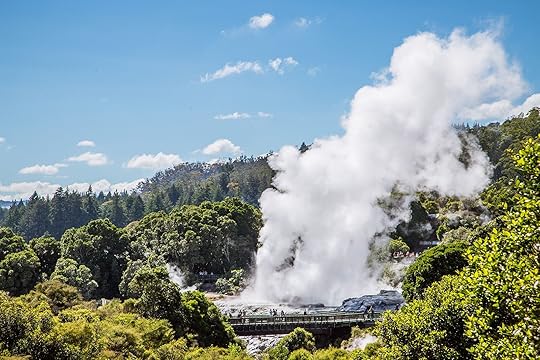 Photo: Clem Hencher-Stevens/Shutterstock
Photo: Clem Hencher-Stevens/Shutterstock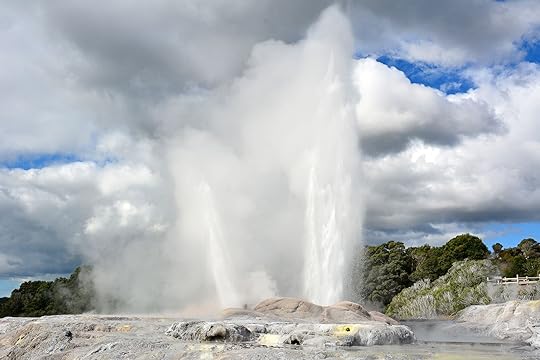 Photo: Alizada Studios/Shutterstock
Photo: Alizada Studios/Shutterstock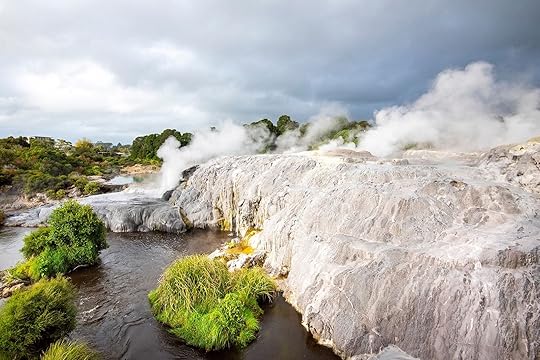 Photo: Adwo/Shutterstock
Photo: Adwo/ShutterstockPōhutu is the largest geyser in the Southern Hemisphere and one of the most popular in New Zealand due to its reliability. It erupts up to 20 times a day, reaching heights of up to 100 feet, with each eruption lasting as long as 20 minutes. The geyser is part of the Te Puia Māori Cultural Centre, which also features hundreds of hot springs and several smaller geysers, making it a rich geothermal attraction.
Nearest City: Rotorua
Accessibility: Access requires an admission fee to the Te Puia Cultural Center. The geyser is accessible via a short walk.
The Andernach Geysir: Andernach, Germany
 Photo: Sergey Dzyuba/Shutterstock
Photo: Sergey Dzyuba/Shutterstock Photo: clawan/Shutterstock
Photo: clawan/ShutterstockReaching up to 200 feet in height, the Andernach Geyser is the tallest cold-water geyser in the world. Contrary to the other geysers on this list that are powered by geothermal activity, Andernacht’s eruptions are produced by the buildup of carbon dioxide bubbles in a deep well. The geyser is a popular tourist attraction, with regular eruptions occurring approximately every two hours.
Nearest City: Andernach, Germany
Accessibility: The geyser can be viewed from a ferry departing from the Geyser Center in Andernach. There’s also a dedicated viewing area.
New York City Hotel Prices Are the Highest on Record After Effectively Banning Airbnbs

The days of staying in an Airbnb in New York City are largely a thing of the past after the de-facto short-term rental ban in September of 2023. While technically still allowed to operate, restrictions like registering stays under 30 days, requiring hosts by physically present during any stay, and limiting to two guests maximum, among others, have effectively cut Airbnb out of the city.
Even before the restrictive laws went into effect, people in the industry were predicted that hotel room rates would go through the roof due to more demand and fewer rentable rooms. And while the short-term rental changes weren’t the only thing that made prices go up since this time last year (about 11 percent of the hotel rooms were repurposed to house migrants over summer), the rental rules play a part in what are now record high average room rates.
The New York Times found the average hotel room in September 2024 in New York City was $417 per night. That’s the highest monthly rate ever for the city — and that was before the holiday season kicked off.
And although this upward trend didn’t creep up with a discrete shoulder tap — real estate analytics company CoStar called this out in September, flagging that the average price of a hotel room had rocketed to $417 — it means that spending the holidays in one of the cities most known for its December festivities is unfeasible for most and impossible for many. Those who do travel to the Big Apple for the holiday spirit will likely have to look to New Jersey and farther out on Long Island for hotels with more reasonable rates. That said, getting into the city is also expensive, and only getting more so with a new congestion plan that will make the city safer for pedestrians and more manageable in terms of traffic, but also add to the cost of getting there.
The Airbnb ban was brought in to help the short-term rental market open up affordable housing for locals. Other cities — such as Amsterdam, Barcelona, and Seville — have enforced similar measures, but the long-term impact on housing is still being evaluated. I’ve personally flitted from one camp to another. As a local trying to buy a house in Edinburgh, I’m cross-cross-apple-sauce in “Camp Ban All Tourists,” but as a traveler, I still want a cheap stay in El Born in Barcelona. And because we’re still to see if bans and restrictions on vacation rentals will make a difference to locals, I’m sure I’ll keep jumping the fence on the subject.
New York City’s official marketing and tourism organization claims there is no indication that visitor levels are decreasing. The 2025 forecast looks bright, with projections estimating 68 million visitors for 2025 — an increase of three million from last. Whether the accommodations options can keep up, and if there are enough wealthy tourists who can afford the ever-increasing hotel rates to sustain that amount of tourism, is an open question.
There are, however, indications that new properties are at least in the planning stage. Skift reports that as of the end of last year, 44 hotels were under construction. This could eventually add more rooms and balance out rates. However, due to zoning rules and permits, hotel development has been restricted and slow in the city. Hoteliers are dealing with red tape and a terrifying juggling act of balancing building budgets and operation costs.
The increase in rates is simply a case of supply and demand. But sadly, it means that your dream NYC holiday might be out of reach — unless you’re willing and able to fork out outrageous rates for a subpar hotel experience. 
The Most Popular Airbnbs Within Driving Distance to Denali National Park

Denali National Park is one of those landscapes you must see in person to properly appreciate. The continent’s highest peak rises above the Alaskan Range at a staggering 20,310 feet, and the park’s expanse, three times the size of Yellowstone, offers an unparalleled wilderness experience. Its untamed beauty, with the absence of manicured parking lots and boardwalks, allows you to immerse yourself in nature’s grandeur. A visit will surely gift you excellent wildlife viewing (big and small), with opportunities to see bears, moose, and wolves, and hiking through the park’s diverse landscapes, from the subalpine forests to the alpine tundra, promises an unforgettable adventure. When visiting, you’ll want to stay in the park in one of the five lodges, backcountry camp, or in a nearby Airbnb. With limited options within the park boundaries, there’s a nice selection of Airbnb properties suitable for couples and families or larger groups in nearby towns and communities. Many of these are located between Talkeetna and Trapper Creek, so there’s still a one to three hour drive involved. But those routes are beautiful and these homes make a great base for exploring the region at large. Here are some of the best options near Denali National Park, which have excellent reviews from past guests.
Authentic Alaskan log home on Talkeetna Village Airstrip Photo: Airbnb
Photo: Airbnb Photo: Airbnb
Photo: Airbnb Photo: Airbnb
Photo: Airbnb Photo: AirbnbSee more photos
Photo: AirbnbSee more photosOne of Airbnb’s top five percent listings — rated for five-star guest reviews, host reliability and communication, cancellation rates, and quality-related issues that have been reported to Airbnb — this authentic Alaskan log home is on Talkeetna Village Airstrip. This home is perfect for those who have their own plane — stay with me here — as you can fly in and park your aircraft in the front yard. For those out of staters who don’t have wings, the house is around 150 miles from the park entrance, making it a convenient base camp for exploring Denali on wheels. The cozy home has been recently updated from top to bottom, including new appliances, cedar tongue and groove, a sauna, and beautiful furniture. You’ll have sweeping views over Denali and the Alaska Range from the nearby Susitna River’s waterfront trail and can even watch planes taking off and landing from the living room.
Six guests, three bedrooms
Price: $375 per night
 Photo: Airbnb
Photo: Airbnb Photo: Airbnb
Photo: Airbnb Photo: Airbnb
Photo: Airbnb Photo: AirbnbSee more photos
Photo: AirbnbSee more photosOn Scotty Lake in Trapper Creek under an hour and a half south of Denali National Park entrance at George Parks Highway, is this charming lodge. It can accommodate up to 14 guests comfortably in its spruce log walls. It’s set on five acres with recreational trails, views of Denali, and promises of wildlife encounters. It’s another top five percent home, with past guests saying not only is it a superb rental for the park, but it instantly feels like home. If you get a rainy day, there’s lots to keep the entire family (or group) entertained with a pool table, karaoke, foosball, and other indoor games.
14 guests, five bedrooms
Price: $713 per night
 Photo: Airbnb
Photo: Airbnb Photo: Airbnb
Photo: Airbnb Photo: Airbnb
Photo: Airbnb Photo: AirbnbSee more photos
Photo: AirbnbSee more photosAnother lakefront property in Trapper Creek is this two-story lodge with an eagle’s nest for wildlife viewing. It’s a stone’s throw from Ermine Lake and the trailhead, and on a clear day, you get a stellar view of Denali. The cabin has three bedrooms, two-and-a-half baths, and a dry sauna. This is another listing with rave reviews. One guest mentioned that Mike, the owner, baked homemade cookies for them — twice. Here’s hoping that continues.
10 guests, three bedrooms
Price: $425 per night
 Photo: Airbnb
Photo: Airbnb Photo: Airbnb
Photo: Airbnb Photo: Airbnb
Photo: Airbnb Photo: AirbnbSee more photos
Photo: AirbnbSee more photosThis secluded cabin is just 40 miles from the entrance to Denali National Park and around 30 minutes from the nearest town (between Willow and Talkeetna). You’ll be close enough for shopping essentials but far enough away to feel like you’re having an Alaskan adventure. The lodge has a spacious and inviting space, featuring a cozy living room with a wood-burning stove, a fully equipped kitchen, and comfortable bedrooms. Large windows offer panoramic views of the surrounding wilderness, allowing you to immerse yourself in the beauty of the Alaskan landscape. In the summer, you can enjoy hiking, fishing, and exploring the nearby trails. Winter offers opportunities for cross-country skiing, snowshoeing, and snowmobiling. The local dog mushing community maintains a network of trails, providing endless possibilities for outdoor enthusiasts regardless of the season.
10 guests, three bedrooms
Price: $447 per night
 Photo: Airbnb
Photo: Airbnb Photo: Airbnb
Photo: Airbnb Photo: Airbnb
Photo: Airbnb Photo: AirbnbSee more photos
Photo: AirbnbSee more photosI love this cabin, not only because of the price, but because I could imagine my family and I being very comfortable in this modern custom-built three-bedroom. It’s also located in Talkeetna, close to downtown and a quarter mile from the Talkeetna Lakes trail system. It’s on a peaceful acre where you’ll find miles of running, biking, and skiing trails. There’s a six-person sauna, multiple sleeping arrangements, heated tile floors, and a spacious arctic entryway to hang up your skis and gear after hitting the trails. If visiting during summer, you can hang out on the large south-facing deck, and there’s a BBQ and firepit on-site, too.
Nine guests, three bedrooms
Price: $199 per night
 Photo: Airbnb
Photo: Airbnb Photo: Airbnb
Photo: Airbnb Photo: Airbnb
Photo: Airbnb Photo: AirbnbSee more photos
Photo: AirbnbSee more photosFor something a little more rustic, check out this historic home in downtown Talkeetna. It’s a family home and is a stone’s throw from the river, shops, and the Fairview Inn, one of the oldest bars still operating in Alaska. If you’re visiting with a dog in tow, this is a great option as it’s pet-friendly, and the hospitality extends to the garden, where you can help yourself to produce.
Eight guests, three bedrooms
Price: $265 per night
 Photo: Airbnb
Photo: Airbnb Photo: Airbnb
Photo: Airbnb Photo: Airbnb
Photo: Airbnb Photo: AirbnbSee more photos
Photo: AirbnbSee more photosThis new build is centrally located in Talkeetna. The main floor features a cozy living room, a well-equipped kitchen, and a spacious bedroom with an en-suite bathroom. Upstairs, you’ll find two additional bedrooms and a shared bathroom. The house is also equipped with a washer and dryer for your convenience. After a day in Denali, you can relax and unwind in the shared outdoor hot tub beneath an Amish gazebo. The outdoor space provides the perfect setting for stargazing, socializing, or simply enjoying the peace and quiet.
Six guests, three bedrooms
Price: $195 per night
 Photo: Airbnb
Photo: Airbnb Photo: Airbnb
Photo: Airbnb Photo: Airbnb
Photo: Airbnb Photo: AirbnbSee more photos
Photo: AirbnbSee more photosThis jaw-dropping cabin is in Willow, so it’s a little further out, approximately a two-hour drive from Denali National Park, but this spacious home provides a tranquil base for exploring the Alaskan wilderness south of the park. Surrounded by breathtaking mountain vistas, it’s an ideal starting point for various outdoor adventures. Hiking trails wind through the surrounding landscape, and plenty of nearby outdoor sports, such as four-wheeling, sightseeing flight tours, rafting, fishing, and snowmobiling, are readily available. The spacious cabin offers comfortable indoor amenities if the weather takes a turn. You can relax by the fireplace, curl up with a good book, or enjoy a family meal in the well-equipped kitchen.
Eight guests, three bedrooms
Price: $595 per night
 Photo: Airbnb
Photo: Airbnb Photo: Airbnb
Photo: Airbnb Photo: Airbnb
Photo: Airbnb Photo: AirbnbSee more photos
Photo: AirbnbSee more photosThis eco-friendly lodge is perched high on a ridge overlooking the Alaska Range and Denali National Park. Built in 2023, this family-owned retreat offers a secluded wilderness experience while remaining close to the charming town of Talkeetna. The lodge features three private eco-domes, each equipped with a king-size bed, a futon, a desk, and chairs. Shared amenities include a sauna house and a clubhouse with a kitchen, dining area, and two bathrooms. And if you’d like to take in Denali from the air, the lodge runs helicopter and floatplane tours. 
Three guests, one bedroom
Price: $357 per night
November 27, 2024
11 Travel and Outdoor Brands to Support on Women-Led Wednesday

Most people know about Black Friday and Cyber Monday, but if you’re going to spend on any made-up shopping holiday, you might as well support one that matters. And that may mean doing some shopping on the Wednesday before Thanksgiving, known as Women-Led Wednesday. It’s an annual initiative designed to get people to consciously shop with businesses owned or led by women. It became an organized effort in 2018 and was started by Cassie Abel, co-founder of Wild Rye, a women’s outdoor apparel company.
As of September 2024, women held 10.4 percent of CEO positions within Fortune 500 companies in the US, with just 52 women serving as chief executives. That’s basically unchanged from 2023, when there were 53 female leaders in the Fortune 500. It’s also a huge disparity when compared to the breakdown of the workforce in the US, as women make up 47 percent of the labor force. It’s a complicated answer as to why more women aren’t in senior and leadership roles, with multiple factors at play.
The underrepresentation of women in leadership roles is influenced by systemic barriers, cultural biases, and structural inequalities, to name just a few broad reasons. One significant factor is the “glass ceiling:” an invisible barrier that impedes women’s advancement to top executive positions. It’s a far more complicated issue than one article can touch on, but in short, it’s a men promoting and preferring peers they share interests and commonalities with (who tend to be other men), and an implicit societal bias that associates leadership qualities with men, but sees those same qualities as bossy or abrasive in women.

Carve Designs has been making lifestyle and outdoor clothing for women for more than 20 years. Photo: Carve Designs
Of course, that’s not the only factor. Women often take a few years out of the workforce to have children between roughly 25 and 35, meaning they’re missing out on career-advancing promotions during that time. They also return to the workforce with a few years less experience than their male peers because of that. Women also often bear a disproportionate share of caregiving responsibilities, which can limit their availability for roles that demand long hours. Doing a larger share of caregiving also means women often feel more significant impacts when workplaces don’t provide work-life balance policies, such as flexible schedules or solid parental leave policies. Those issues lead to a lack of mentorship and support, which means men continue to be given more leadership roles.
But the good news, at least when it comes to Women-Led Wednesday, is that the number of companies owned by women is growing, especially in the travel and outdoor industries. Rather than trying to work their way up in established companies, more and more women are starting their own companies from the ground up. In 2018, there were roughly 100 companies on the Women-Led Wednesday retailer list. Today, there are more than 800.
If you’re shopping around Thanksgiving this year, consider making a conscious decision to browse gear from brands owned by women before going to the usual box stores or buying from the same global brands. Here are 11 of Matador Network‘s favorite travel and outdoor brands owned or led by women, all of which are having serious sales on and around Women-Led Wednesday.
We hope you love the gear we recommend! Just so you know, Matador may collect a small commission from the links on this page if you decide to make a purchase. Sale information is accurate as of the time of publication.
Kula Cloth
View this post on Instagram
A post shared by Gabriela “Forward” Fulcher | MOUNTAINS | OUTDOORS | ADVENTURES (@gabihikes)
For women who find themselves occasionally needing to pee outdoors, but don’t want to carry toilet paper or look for recognizable leaves, Kula Cloth is the answer. It’s a machine-washable, antibacterial cloth used when you have to pop a squat in the woods. There’s a funky design on one side to make it very clear which side you touch with your hand, and it snaps shut so the dirty part folds against itself when not in use. It also clips easily to backpacks (or anything else), so you don’t need to smush it in your bag with everything else. You can use it a few times in a row between washings, in case you’re doing a full-day hike. Kula Cloth was started by a former backpacking guide in Washington state and is named after Kula Khangri, the tallest mountain in Bhutan.
Sale info: Varies, starting at $14.95 (regularly $22)
Shop NowWild Rye
View this post on Instagram
A post shared by Wild Rye (@wild_rye_)
Wild Rye started nearly a decade ago and was one of the first brands out there to make mountain bike clothing just for women. It was during a time when biking brands were almost exclusively for men, and if they were lucky, women would have maybe one or two available options. Wild Rye changed that when it launched in 2016, and now, it’s expanded into a full range of outdoor and general lifestyle clothing, still focused on women. Cassie Abel, Wild Rye’s founder, started Women-Led Wednesday — so the brand takes women’s leadership and advancement quite seriously.
Sale info: 25 percent off everything on WildRye.com, free shipping for order over $75. Runs Nov. 21-Dec. 2
Shop NowLo and Sons
View this post on Instagram
A post shared by Lo & Sons (@loandsons)
For luggage and travel bags that hit the sweet spot between stylish, high quality, and sustainable — not to mention affordable — take a peek at Lo and Sons. The brand was started by Helen Lo, a woman in her 60s (so it’s literally never too late to start a business if you have a great idea) who couldn’t find a bag she could carry without back pain. The brand makes very highly rated bags, has a huge selection of products made with vegan leather alternatives, and is continuously introducing new sustainability initiatives, like lines of bags made with up-cycled materials and fabrics. The Catalina Deluxe is probably its most popular bag, with a separate bottom shoe compartment reviewers seem to be obsessed with.
Sale info: Up to 70 percent off site-wide through Dec. 1
Shop NowCarve Designs
View this post on Instagram
A post shared by CARVE DESIGNS (@carvedesigns)
If you love the surfer, Cali-vibe lifestyle, whether or not you’ve ever touched a surfboard in your life, you may like Carve Designs. It was one of the first women-owned brands to put a focus on sustainable materials, and uses a majority of recycled and recyclable materials. It’s also one of a small (but growing) number of brands that uses women of various sizes and shapes in its marketing without calling attention to it — you know, almost like it’s normal for bodies to come in different sizes. Crazy, right?
Sale info: 75 percent off sale items, 30 percent off a select “Cyber Collection” (gear never marked down before).
Shop NowSteamLine Luggage
View this post on Instagram
A post shared by SteamLine Luggage | Travel Beautifully (@steamlineluggage)
We dare you to find a luggage brand more stylish than SteamLine, which makes various bags that can’t be described as anything other than old-school glamorous. It was founded by a traveling mom in 2008 who wanted luggage that was both chic and high-quality. Think of your favorite trendy roller bag that’ll last forever, and combine it with the kind of bag Grace Kelly would have used, and boom — you have Steamline Luggage. Bags are definitely pricey, but designed to last a lifetime. Depending on the bag, it’ll be made with materials like sustainable or vegan leather, recycled bottles, or natural linen. It also offers a repair service, whether your bag is still under warranty or not.
Sale info: 30 percent off sitewide.
Shop NowSkida
View this post on Instagram
A post shared by Skida Headwear & Accessories (@skidagram)
Skida makes stylish, cute, and quality-made beanies and headwear, which may not in itself be super unique. But what is unique is the woman-owned brand’s commitment to being good business leaders. The company has a commitment to ensuring it’s always pushing to be “more inclusive and actively anti-racist in our local and national community.” It also produces everything on-site in Vermont (a state that knows a thing or two about keeping warm), and has a fiber waste rate of just one percent — meaning 99 percent of its materials end up in products, not on a factory floor.
Sale info: 25 percent off everything. Runs Nov.27-Dec.2.
Shop NowtrekALLa
View this post on Instagram
A post shared by trekALLa (@trekalla_apparel)
It’s 2024, and it’s common knowledge that athletes come in all shapes and sizes. Yet for some reason, most outdoor brands only seem to go up to a size XL for women — maybe an XXL, if you’re lucky. Enter trekALLa: a brand that caters to female athletes in sizes up to 6X. It ensures items are cut to fit curvier women, rather than rather scaling up straighter cuts designed for narrower bodies. It’s a fairly new brand, so right now, it makes just a few basic items. But if you’re looking for an inclusive brand for some outdoor basics, trekALLa could be a good fit (pun intended).
Sale info: 25 percent off leggings, half-off offers on hoodes, and more
Shop NowShredly and Curious Creatures
View this post on Instagram
A post shared by Women’s MTB Network (@womensmtbnetwork)
Okay, just to avoid any confusion: Shredly and Curious Creatures are two unaffiliated companies. They’re probably competitors. But the gap they fill in the outdoor industry — bike clothing for women in a range of sizes — is so big that there’s plenty of room for multiple brands. Shredly has a wider range of gear, while Curious Creatures makes super fun, matchy-matchy bike kits so you can send it in style. This writer crushes winter rides in a pair of mud-stained Shredly Limitless Pants, and I’m itching to try a few pieces from Curious Creatures, too. Shredly goes up to a size 20, while Curious Creatures sizes up to women’s size 18.
Shredly sale info: Up to 70 percent off sitewide
Curious Creatures sale info: 25 percent off flash sale
Shop NowShop NowOboz
View this post on Instagram
A post shared by Oboz Footwear (@obozfootwear)
Move over, big-name hiking shoe brands: Oboz is a serious contender for the best hiking boots around, and better still, it’s female-led. President Amy Beck worked at global brands like SmartWool and Cole Haan before taking the reins at Oboz, and now leads the company known for making footwear awarded by everyone from Outside Magazine to Gear Junkie. Oboz plants a tree for every pair sold, displays its sustainability and diversity initiatives for the world to see, and keeps shoe prices affordable — waterproof hiking boots are about $135 during the brand’s Women-Led Wednesday sales.
Sale info: 25 percent off sitewide
Shop NowKleen Kanteen
View this post on Instagram
A post shared by kleankanteen (@kleankanteen)
Kleen Kanteen is a reusable drinkwear brand founded in 2004 and originally sold at music festivals across California as an alternative to plastic bottles. For the last 20 years, it’s been co-owned by Michelle Kalberer, who has expanded the brand into a wide range of travel drinkwear and food storage gear. It’s a 1% for the Planet company and a certified climate-neutral business, and makes about 95 percent of its products with recycled steel. It also offers budget-friendly replacement parts, rather than requiring users to buy a whole new item if something breaks or wears out. 
Sale info: 25 percent off sitewide
Shop NowMore like thisTechnology + GearThe Ultimate Holiday Gift Guide For Travelers, From Under $50 to Over $2,000An Invertebrate Zoo May Be the Quirky Attraction Your Next Vacation Needs

In the wild, sea urchins decorate their spiny bodies with bits of shells and fallen mangrove leaves. But the urchins who live at the Butterfly Pavilion in Westminster, Colorado, have expanded options, thanks to an intern graduate student who 3D-printed for them tiny hats to see which styles they’d choose. Most of the urchins have a sophisticated flair, opting for top hats, though a few have gravitated toward Viking helmets and baseball caps.
View this post on InstagramA post shared by Butterfly Pavilion (@butterflypavilion)
This experiment isn’t meant to be cute. It’s legitimate scientific research to learn more about the “covering behavior” sea urchins display in the wild – though it does serve the unintentional purpose of showing how endearing urchins can be. And that’s part of the point, said Sara Stevens, Director of Animal Collections at the Butterfly Pavilion. “It helps people really see them as animals with personalities, not just little balls of spikes,” she says.
Invertebrates, such as sea urchins, are animals that don’t have a backbone – or any bones, for that matter. Examples of invertebrates include spiders, bumblebees, beetles, and lobsters, and they make up somewhere between 97 and 99 percent of all animal species on Earth, depending who you ask.
“These remarkable creatures are more than fascinating. They are the foundation of all life on Earth, playing critical roles in pollination, nutrient cycling, and maintaining the balance of ecosystems that sustain us all,” said Stevens.
That means as humans, our well-being depends on a thriving and diverse invertebrate population. But they’re increasingly in trouble due to habitat loss, pesticide use, and climate change. So it’s more important than ever for us humans to find an expanded appreciations of the fascinating cast of characters in the invertebrate world. Some of those are charming gateway animals (meaning exciting animals that serve as an entry point for someone to engage more deeply with the natural world), such as octopuses and butterflies. Others can take a bit of warming up to, at least for some of us — especially for those that crawl.
Fortunately, a great way to nurture the process of becoming more comfortable with some of the more unique creatures around the world is to visit an invertebrate zoo when you travel. “Once we start sharing that these animals exhibit really interesting behaviors, people start to lower their guard, and that’s one of my favorite things in the world,” said Stevens.
Besides helping to expand personal boundaries and fostering curiosity, some invertebrate zoos are also important research centers and habitat conservation hubs, so buying an admission ticket helps fund that work. They’re also great places to learn about local fauna and how to help protect it. If you’re planning on outdoor activities while you travel, like trekking, cycling, or paddling, going to an invertebrate zoo ahead of time can add an extra layer of adventure. That way, you’ll be able to identify some of the mollusks (like snails and clams), annelids (worms), and arthropods (insects) you may see while outdoors in a new part of the country or world.
Some invertebrate zoos are considered “insectariums,” focusing solely on either butterflies, or insects in general. Others, like the Butterfly Pavilion, expand the scope into marine invertebrates and arachnids. Regardless of who lives at the zoo you visit, Stevens offers these tips to make the most out of your trip.
Talk to staff members. They can tell you all of the animals’ quirks plus their favorite hiding spots, so you’ll see some you might have otherwise unknowingly passed by.Be patient and observant. “I see a lot of people glaze over an exhibit, not realizing it has tons of animals in it,” said Stevens. “But if you look closely and you take your time, you can really see some incredible behaviors.”For a quieter experience, go in the afternoons, when there’s a smaller chance of encountering school groups on field trips.Seek out Association of Zoos and Aquariums (AZA)-accredited facilities, and only visit facilities that maintain high standards of animal welfare.And if you want to get a butterfly to land on you, stand very still in a sunny spot, said Stevens. It also helps to wear bright colors, like yellows and reds. Remember, it’s okay if they touch you, but never touch back. Always check the ground before you step backward to make sure a butterfly isn’t sunning behind you on the ground.Invertabrae zoos aren’t as popular or as well known as regular zoos or animal sanctuaries, but there are more out there than you’d think. Here are a few notable ones in tourism hot spots around the world.
View this post on Instagram
A post shared by Saint Louis Zoo (@stlzoo)
Like many invertebrate zoos, one of the main attractions of the Bayer Insectarium at the Saint Louis Zoo is butterflies. There, they flutter about in a tropical, geodesic dome shared with everything from rare flowers to dragonflies and turtles. The Insectarium has an additional 20 or so major exhibit areas that house more than 100 species of live insects and arthropods, including centipedes, flamboyant flower beetles, silk worms, and venomous golden orb-weaver spiders.
The insectarium is part of an active research and conservation breeding facility, and visitors can watch entomologists at work and even ask them questions about their research. If the insects aren’t enough to keep you occupied, the surrounding 90-acre AZA-accredited St. Louis Zoo should do the trick.
Address: 1 Government Drive St. Louis, MO 63110Hours: Varies, currently 9 AM-4 PMAdmission: Free (as is the zoo)Butterfly Pavilion (Westminster, Colorado)
Photo: ZHartman Photography/Shutterstock
One of the Butterfly Pavilion ’s most popular exhibits is a 7,000-square-foot, walk-through tropical rainforest, home to a couple thousand butterflies. It also maintains a focus on marine invertebrates, with Colorado’s only Caribbean coral exhibit, complete with horseshoe crabs, shrimp, and sea stars. Other not-to-miss experiences include the tarantula ambassadors Rosie and Goldie (who guests can hold), a leaf-cutter ant colony, and native outdoor habitat gardens, as well as a play area popular with kids and families. Interestingly, the Butterfly Pavilion is peculiarly popular for date nights, said Stevens.
The Butterfly Pavilion is the world’s first AZA-accredited standalone invertebrate zoo, and as a nonprofit organization, focuses much of its scientific and research work on local and global habitat conservation and community outreach. It’s about 20 minutes north of downtown Denver, making it easy to reach for families visiting the city.
Address: 6252 W 104th Ave, Westminster, CO 80020Hours: Daily, 9 AM-5 PMAdmission: $10.95 for children, $13.95 for seniors 65+, $15.95 for adultsThe Audubon Insectarium at the Audubon Nature Institute (New Orleans, Louisiana)
Photo: Kit Leong/Shutterstock
This insectarium is particularly beloved for its butterfly garden overlooking the Mississippi River, especially as guests can reserve a spot to help butterflies take their first flight as they leave the pupa stage of their lifecycle. But it also has more than 50 displays with live arthropods, or bugs with exoskeletons (like beetles, centipedes, and spiders), as well as a honey bee colony with clear viewing walls. It takes about an hour to go through (unless you stop for a snack to eat some of the locals at the Bug Appétit exhibit).
The facility is in downtown New Orleans in the historic former US customs house, next to the Audubon Aquarium. Both are AZA-accredited and maintain a heavy focus on conservation, research, and community outreach, and one ticket is good for entry to both destinations.
Address: 1 Canal St, New Orleans, LA 70130Hours: Daily, 10 AM-5 PMAdmission: $34.95 for children and seniors, $35.95 for adults (includes aquarium)The Richard M. Bohart Museum of Entomology (Davis, California)View this post on Instagram
A post shared by Bohart Museum (@bohartmuseum)
The Bohart Museum houses one of the largest bug collections in the United States, with more than seven million species from around the world, including 35,000 tardigrades (also called “water bears”). It also hosts the California Insect Survey, a storehouse of insect biodiversity first collected in the 1930s. As for live animals, there’s usually a few to be found, including walking sticks (also known as stick bugs, or phasmids), tarantulas, and hissing cockroaches.
The museum is part of the University of California at Davis, and at first glance, seems small. But it’s a working entomology lab, which means the students there can expand your visit into a much longer affair by showing you cases that aren’t on public display. Visiting is completely free, but the hours can vary, so check the website in advance before your trip.
Address: University of California, Davis, Academic Surge, 455 Crocker Ln Room 1124, Davis, CA 95616Hours: Varies; currently Tue & Wed, 1:00-4:30 PMAdmission: FreeThe National Butterfly Center (Mission, Texas)
Photo: Danita Delimont/Shutterstock
On the southern tip of Texas in the Rio Grande Valley sits the National Butterfly Center. It’s an outdoor sanctuary where more than 200 species of butterflies have been spotted. According to the center, that’s the “greatest volume and variety of wild, free-flying butterflies in the nation.” The flutterers aren’t contained, but choose to stay there, thanks to the welcoming subtropical climate – and the fact that Butterfly Center staff created the perfect habitat for them by planting the largest native plant botanical garden in the country.
While roaming the trails in the 100-acre preserve, you’re bound to see a lot of other interesting insects, birds, and other native wildlife. The center is part of the North American Butterfly Association, a nonprofit dedicated to teaching people how to create and conserve butterfly habitats.
Address: 3333 Butterfly Park, Mission, TX 78572Hours: Daily, 8 AM-5 PMAdmission: $5 for children, $10 for adultsDr. Beynon’s Bug Farm (St. Davids, Wales, UK)View this post on Instagram
A post shared by Andy Holcroft (@andyholc_photography)
A combination of wildlife conservatory and farm, The Bug Farm includes a museum with one of the UK’s largest private butterfly collections, a tropical invertebrate zoo with live bugs from around the world, and even a bug art gallery. It sits on a 100-acre farm and wildlife habitat, with lots of walking trails.
The whole experience, including a cafe serving up insect-based dishes like spiced cumin and mealworm hummus or mixed insect pakoras. The entire experience is meant to encourage and teach guests about sustainable farming and eating, while also inspiring people to look for and appreciate invertebrates in their daily lives. The Bug Farm also dives into conservation work, including planting woodland habitats and trying to bring back the locally extinct marsh fritillary butterfly.
Address: Lower Harglodd Farm, St Davids SA62 6BX, United KingdomHours: Varies seasonallyAdmission: 8.50 euros for adults (about $8.50), 6.5 euros for children (about $6.50) More like thisMuseumsThese Museums, Zoos, and Aquariums Will Let You Spend the Night
More like thisMuseumsThese Museums, Zoos, and Aquariums Will Let You Spend the Night
Matador Network's Blog
- Matador Network's profile
- 6 followers



